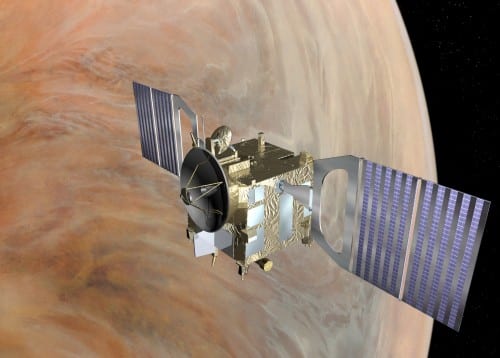On January 18, the European Space Agency made last contact with the Venus Express spacecraft and its fate has not been known since then. Most likely it was already melted on the surface of Venus

After eight years of activity in orbit around Venus, Venus Express completed a long series of observations and measurements planned for it before launch and those planned for it during its flight with each extension of the mission. The spacecraft worked perfectly. It was launched on November 9, 2005, entered orbit around Venus on April 11, 2006, was planned for two years of work and has continued to work until today. In 2014 it entered its final phase. The dwindling supply of fuel brought her to the end of her journey. Her normal flight route was 225 - 66,000 km and the whole trip lasted 24 hours. In the final stage, it was decided to lower the pricenter point deeper into the atmosphere. Although there were entrances and exits to the low point, 165 km above the ground, but they were for short periods of time. Since the spacecraft was at the end of its journey, it was decided to further lower the pricecenter to 130 km. The flight was planned to take place between June 18, 2014 and April 11, 2014. Naturally, the options in this situation are extremely limited and they focused on the magnetic field, the solar wind and the atmospheric pressure. The researchers had an opportunity to research essential techniques for aerodynamic braking (aerobraking) for future programs (1).
Reduction of the possibilities at this stage of the flight was due to two reasons. One reason is that research programs are decided months in advance and at this stage of the flight it is not possible to do so. The second reason is related to the flight path. All the instruments of the spacecraft are located on one side of the spacecraft and precise orientation of the instruments towards observation targets is no longer possible. In the position of the spaceship where it is in aerodynamic braking, the possibilities are extremely limited and basically aim for zero. In this mode, observations are made that do not require precise tuning of the spacecraft's instruments. In other words, every observation that can be made is squeezed out of the spacecraft.
It was decided to make these observations in blocks of time units. Less than four hours from the duration of the entire coffee, observations and measurements can be made. If the time part of the lap is unusable, there is a problem, whether it is the research instruments or the crew supervising the flight. In this case, the time block of that coffee will not be used. What burdens the research is the sun racks used for aerodynamic braking, since the spacecraft is then inside the atmosphere and the sun racks cannot absorb the full light of the sun. The spacecraft operates under conditions of uncertainty (2).
On June 23, the pricenter was lowered by 2.8 km and the next day, on June 24, another lowering was carried out. The supervisors said they are entering a completely new phase as they penetrate deeper into the atmosphere. This is done on the day side of the planet. A week later we enter the night side and expect the density of the atmosphere to drop significantly, although we don't know by how much(3). On July 14, the price center was lowered from 130.21 km to 129.1 km. At this stage, the effects of atmospheric drag on the spacecraft at low altitudes were measured. It is possible to study how the density of the atmosphere changes on a local scale and on a global scale (4).
On July 15, a series of commands were transmitted to the spacecraft to perform maneuvers for 15 days that would raise the low point in the orbit to 460 km (4). For this purpose, 5.2 kg of fuel was used (5). On November 26, it was reported that between November 23 and November 30, a series of maneuvers is planned to raise the pricenter in an attempt to maintain the function of the spacecraft. The intention was to maintain its function into the year 2015 (6). On December 18, 2014, it was reported that the spacecraft ran out of fuel and will burn up in the atmosphere in January 2015 (7).
On January 18, the last contact was made with it and it is estimated that it will disappear into the atmosphere during the months of January-February. Today we are at the beginning of March and apparently the final crash has already occurred, but there is no way to verify this.
Sources
1. "Venus Express gets ready to take the plunge" 20.5.2014
http://www.spacedaily.com/reports/Venus_Express_Gets_Ready_To_Take_The _Plunge_999.html
2. Daniel- "Science during aerobraking" 18.6.2014
http”//blogs.esa.int/rocketscience/2014/06/18/Science-during-aerobraking/
3. Daniel-"Venus Express enters unknown realm" 23.6.2014
http://blogs.esa.int/rocketscience/2014/06/23/venus-express-enters-unknown -realm
4. "Venus Express rises again" 14.7.2014
http://www.spacedaily.com/reports/Venus_Express_Rises_Again_999.html
5. "Venus Express: Up above clouds so high" 29.7.2014
http://www.sci.esa.int/venus-express/54411-venus-express-up-above-clouds-so- High
6. "Venus Express will raise orbit and keep going" 26.11.2014
http://blogs.esa.int/rocketscience/2014/11/26/the-little-satellite-that-could-orbit-and-keep-going
7. Stephen Clark – “Europe's Venus Express rises to its end” 18.12.2014
http://spaceflightnow.com/2014/12/17/europes-venus-express-rises-to-its- end
